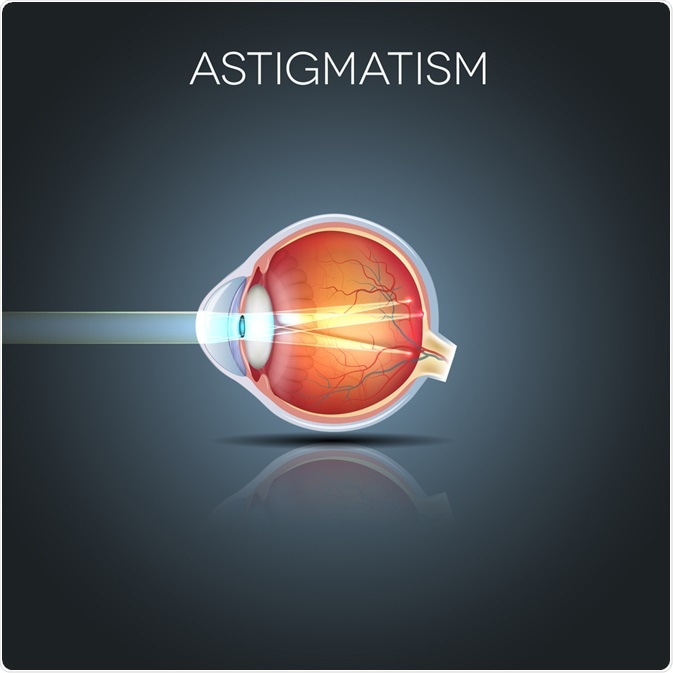Astigmatism is a refractive error that creates asymmetric blur in the vision due to the irregular corneal curvature/shape (corneal astigmatism) or the lens (lenticular astigmatism). Due to this condition, the light rays that enter the eye fail to converge at a single focal point on the retina and form two foci instead. The lack of a single focus point results in the formation of blurred images on the retina.
Clinically, astigmatism is commonly seen in combination with other refractive errors such as myopia, hyperopia, or sometimes as mixed.
Regular astigmatism vs irregular astigmatism, corneal curvature - A State of Sight #57
Regular and irregular astigmatism
There are various classifications of astigmatism that are defined on the basis of the clinical factors and other characteristics. Apart from that, this type of refractive error can also be grouped into regular and irregular based on the contribution of the ocular components and their orientation.
The perpendicularity of the principal meridians of the cornea determines whether the astigmatism is regular or irregular. Considering the center of the pupil as a pole, imaginary lines are drawn around the eyeball that is intersected at the poles at both anterior and posterior positions, which are called the meridians of the eye. The flattest and steepest meridians of the eye are termed the principal meridians.

Image Credit: Tefi / Shutterstock.com
Regular astigmatism
Irregular corneal or lens curvature of the eye causes regular astigmatism. In this condition, the principal meridians are always 90˚ apart from each other and, in this case, there will be a consecutive variation in the refractive power from one meridian to another. Each meridian in the regular astigmatic eye has a uniform curvature at every point across the entrance of the pupil.
This is the most common type of astigmatism in which the symptoms included are blurry vision, headaches, and light sensitivity, to name a few.
Types of regular astigmatism
Regular astigmatism can be further classified into three types that include with-the-rule, against-the-rule, and oblique astigmatism. With-the-rule astigmatism, for example, is common among children where the vertical meridian is the steepest and it stays close to 90˚.
Comparatively, in against-the-rule astigmatism, the horizontal meridian stays close to 180˚, which is steeper than the vertical meridian. Against-the-rule astigmatism is common in the elderly.
Thirdly, oblique astigmatism is diagnosed if the principal meridians are not at 90˚ or 180˚. Here, the shape of the eyeball resembles a tilted American football, with its prime meridians lying between 30˚–60˚ and 120˚–150˚.
Correction
Standard ophthalmic lenses are widely used in correcting regular astigmatism. Soft or rigid gas permeable (RGP) spherical contact lenses are the best to correct astigmatism that shows lower sphere refractive error than 1/3.
Contact lenses and surgical procedures are the other methods that can be used in the correction process. Visual acuity will be better when using RGP lenses as compared to soft contact lenses for patients with regular astigmatism.
Irregular Astigmatism
In irregular astigmatisms, the principal meridians are separated by any angle other than 90°, i.e., they are not perpendicular to each other. In this type, the curvature at each meridian is not uniform but changes from one point to another across the entrance of the pupil.
A small amount of irregular astigmatism is seen in every eye when the entire cornea is assessed; however, this is medically irrelevant. Irregular astigmatism, which is clinically relevant, is very uncommon compared with the regular form. It is seen in patients with an irregular corneal surface that occurs either due to natural causes or are causes that are surgically induced.
Different corneal pathologies related to elevated lesions, like Salzmann's nodular degeneration or keratoconus, are the natural causes of irregular astigmatism. These causes lead to primary irregular astigmatism and secondary irregular astigmatism.
Astigmatism that is surgically induced can be caused due to removal of the pterygium, extraction of cataract, lamellar as well as penetrating keratoplasty, radial and astigmatic keratectomy, myopic keratomileusis, and laser in situ keratomileusis (LASIK).
Corneal trauma and infections are other important causes of irregular astigmatism.
Types of Irregular Astigmatism
There are two types of irregular astigmatism that include macro-irregular and micro-irregular astigmatisms.
Macro-irregular astigmatism can be defined as irregular astigmatism with defined patterns or regularly irregular astigmatism. The primary cause of this type of astigmatism is the formation of a steep or flat area that is at least 2 mm in diameter.
Micro-irregular astigmatism can be defined as irregular astigmatism with undefined patterns or irregularly irregular astigmatism. This happens when multiple irregularities come together, which can be big, small, steep, or flat. Calculations using profile maps are very difficult in such conditions.
Correction
It is difficult to correct irregular astigmatism with standard spectacles, as this cannot provide actual visual acuity and the images seen will be blurred in nature. Obliquely crossed cylinders and other surgical techniques are being proposed in such cases.
Visual acuity cannot achieve perfection even in the best available treatments regarding irregular astigmatism. To improve this condition, the use of contact lenses is an alternative approach.
References
Further Reading